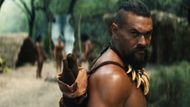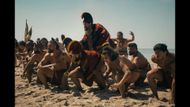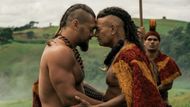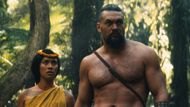Chief of War is based on true events. It’s one of those stories that wait. Sometimes for decades. Sometimes longer. The historical series from Apple TV+, created by Jason Momoa and Thomas Paʻa Sibbett. From the way it opens to how it was filmed and spoken, it carries a promise. This isn’t just a show made to entertain. It’s something that needed to be told.
Chief of War takes place in the Hawaiian Islands, sometime in the late 1700s, right before everything started to shift. It was that moment when old systems were still holding on, but change was already close enough to feel. Some chiefs understood what was coming. Others held their ground, hoping it might pass.
In the middle of it all was Kaʻiana. A warrior, but not just that. Someone who had seen the world, then returned to find his own land different, or maybe just harder to recognize.
The series is told in ʻōlelo Hawaiʻi, the language spoken before outsiders arrived. Every scene was filmed on land that holds meaning. The team brought in people who knew the history, who carried it with them. Historians, cultural advisors, language experts, all of them were part of the process from the beginning.
This wasn’t just about telling a story. It was about giving that story its own breath again. Before it became a show, it was already something else. A way to speak, after being quiet for too long.
The figure of Kaʻiana
Kaʻiana was a real historical figure. In Chief of War, he’s presented not as a legend, but as someone whose story had been buried under generations of silence. What makes him stand out is how far he traveled, long before most others ever left the islands.
He saw the world beyond Hawaii, China, the Philippines, Alaska, and moved through places already marked by change. Places where power had shifted, where disease had spread, where control came from outside.
According to Jason Momoa, Kaʻiana came back carrying that knowledge like a warning. He had witnessed what happened when foreign systems took hold. He had seen people stripped of their freedom. The urgency he brought home wasn’t something everyone wanted to hear. His perspective had shifted, and not everyone was ready to meet him where he was.
Chief of War leans into that discomfort. It doesn’t soften the contradictions. It shows Kaʻiana as a figure caught between duty and disconnection. He’s respected, but also watched with suspicion. His intentions are clear, but his methods don’t always land the right way.
There’s a kind of sorrow in that. A distance that builds slowly, not from betrayal, but from how much the world around him has changed. His path is anything but clean. It’s shaped by conflict, blurred by emotion, and never entirely resolved.
A production without precedent
Chief of War marks the first major series spoken almost entirely in ʻōlelo Hawaiʻi. That alone makes it unique. But it’s not just about language. It’s about structure. The production was Indigenous-led. The cast includes actors from across the Pacific, including Māori veterans like Temuera Morrison and Cliff Curtis. Others had never acted before.
Kaina Makua, who plays Kamehameha, is a respected kalo farmer and cultural practitioner. He initially turned down the role. He had no desire to become an actor. What changed his mind wasn’t the scale of the project, or the names attached to it. It was the idea that the story could become part of something lasting. A gift, as much for future generations as for the elders who never saw this history told.
That spirit shaped every detail. Tikis were carved by hand. Canoes were built using traditional techniques. Scenes were filmed in locations with ancestral weight. The result isn’t polished in the way some viewers might expect. It doesn’t aim for perfection. It aims for presence.

Language and reconnection
Working in ʻōlelo Hawaiʻi meant that most of the actors had to learn the language from the ground up. Within the context of Chief of War, that challenge became part of the process. Some cast members had coaches living with them during filming. Scenes were repeated until the rhythm felt right, until the pronunciation matched the weight of the words. It wasn’t easy. But it moved beyond rehearsal. It turned into something else.
Luciane Buchanan, who plays Kaʻahumanu, said that speaking the language brought her closer to the role. Even without understanding every word, the sound alone carried emotion. Temuera Morrison described it as a form of memory. For him, the Hawaiian language wasn’t just dialogue. It became a channel. It gave shape to the history his character carried.
Jason Momoa also took on the challenge. He thought it would come easily. It didn’t. Others learned faster. He said so himself. But that made the work even more meaningful. It took time. It asked for presence. And within Chief of War, that effort became part of the story being told.

A volcanic response
While filming the final battle scene, something unexpected happened. The production had chosen a real lava field as the location, aiming to recreate a historic volcanic eruption tied to a key moment in Hawaiian history. Then nature responded. Mauna Loa erupted the night before filming began. The next day, Kīlauea followed. It wasn’t planned. It wasn’t predicted.
The shoot lasted eight days. When it ended, the volcanoes went quiet. For those on set, it didn’t feel random. In Hawaiian tradition, moments like this are called Hōʻailona, signs that the land is listening, maybe even speaking. Later, on the day of the show’s premiere, ancient petroglyphs were unexpectedly revealed at Pokai Bay, where Jason Momoa had grown up surfing.
These weren’t treated as coincidences or spectacle. They were moments of alignment. The story being told had weight, and the island, somehow, seemed to acknowledge it.

Chief of War and the shape of conflict
The story told in Chief of War isn’t a straightforward tale of conquest or rebellion. It doesn’t pick sides. Kaʻiana isn’t presented as a flawless figure. At times, he seems like he’s working against the people he wants to protect. His choices lead to consequences that hurt those around him. And yet, the story doesn’t frame him as a villain.
There’s a love triangle within the narrative. It mirrors the political tension. There’s loyalty and betrayal, but also a kind of longing that doesn’t settle. It plays out slowly. With pauses, with distance. It’s not used to distract from the larger story. It echoes it.
The relationship between Kaʻiana and Kamehameha stays mostly in the background. It shapes the conflict but doesn’t dominate it. That space allows the viewer to focus on what’s changing. Not just politically, but emotionally. The land, the language, the power structures. All of it is in motion.

Where to watch and when
Chief of War is scheduled to premiere on August 1, 2025, on Apple TV+. The first two episodes will be available at launch. The rest of the season will unfold weekly. The final episode is expected to release on September 19. The series will include subtitles and dubbed versions, but the original language version is at the core of the project.
Why It matters
Chief of War arrives not as a grand announcement, but as a correction. A restoration. It tells the story of a man who saw too much and spoke before others were ready to listen. It shows what happens when memory returns with weight. When land and people align to retell what had once been lost.
There’s no promise that everyone will connect with it the same way. The pacing is different. The language sounds unfamiliar. The rhythm follows another path. But it carries something honest. Something that doesn’t ask to be explained. Just watched. Just heard.
This is what it means for the land to remember. For voices to rise again in a language that once fell silent. That’s what Chief of War brings forward. And that’s what it leaves behind.
